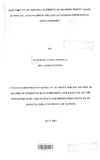Heritability of mineral elements of micronutrient value in two Solanum Scabrum (miller) accessions from Kenya and Cameroon
Abstract
Indigenous leafy vegetables account for 75.3% of all vegetables consumed in Africa
and eight families account for 50% of the indigenous African leafy vegetables with
Amaranthaceae and Solanaceae ranking at the top. Solanum scabrum belongs to
Solanaceae family and is popularly consumed as a vegetable soup in Kenya. Two S.
scabrum accessions were used for this study GPA62 (an accession from Cameroon)
and GPA111 (an accession from Maseno-Kenya). GPA62 and GPAll1 were crossed
from which F1 plants were generated. F2 generation plants were generated by selfing
Fl. Energy Dispersive X-ray Fluorescence (EDXRF) analysis was undertaken on
GPA62, GPA111, F1 and F2 leaves to determine mineral elements of micronutrient
value. The micro and macro element concentration in leaves of GPA111 was compared
to GPA62 and F2 progeny and heritability determined. Heritability was estimated based
on 2 criteria namely: single elements criterion 'a'; and Macro elements (MAE)
concentration (potassium and calcium summed) and microelements (MIE) (manganese,
zinc and iron summed) as criterion 'b'. Genstat 5.1 was used to calculate the parentoffspring
heritability from linear regression analysis ANOVA. Chi-squares were used
to find out the mode of inheritance. The parent-offspring regression and Chi-square
results showed that the uptake of single elements had very low heritability levels «0.1)
and that factors were probably inherited independently. However, when classified
under MAE and MIE criterion, GPA111 gave a high heritability of 0.24 on MAE while
GPA62 gave 0.074. Heritability estimate on criterion 'a' is the most conventional
criteria amongst the named above. Heritability estimate on criterion 'b' considers the
summation of both K and Ca under MAE in terms of their position on the Periodic
Table of elements. MIE has the trace elements summed in the category of heavier
metals in the Periodic Table. Therefore, there is a biological merit in the use of single
element and MAE-MJE heritability criteria. In fact the MAE-MIE heritability criterion
appears to have improved the values obtained compared to the single element criterion.
These heritability values, however, have limitations that ought to be recognized as thus:
heritability (h2
) is generally population and environment specific; further more, it is a
population rather than individual parameter. It was adopted in this study because the
two ecotypic strains used as parental lines for crossing were regarded as population
based rather than individual variety characterized. Therefore, the estimates thus derived
from this study were probably not indicative of the degree to which the mineral density
trait is genetic but rather suggestive of the proportion of phenotypic variance due to
possible genotypic factors. Chi-square values are suggestive of a monogenic
inheritance of mineral density in S. scab rum. On the overall, data also suggest that
mineral micronutrient density is not entirely genetic and the environmental component
in the phenotype may to a large extent be playing a role in the leaf concentration. In
general, F2 from the two crossed parents showed higher mineral densities than the
parents. Further investigation focussing on (Genotype) x Environment (G-E)
interaction and studies on specific and general combining abilities (GCA) on selected
individual strains or cultivar/ecotypes are warranted. This GCA line of inquiry will
yield data on average performance of parental lines as characterized by the average
amount of heterosis in all hybrid combinations. It would also be useful for determining
mineral density of parental lines, among the genetic components and a breeding method
for high mineral density. In mean time, farmers can expect high mineral micronutrient
yields by prudently applying appropriate agronomic husbandry interventions such as:
(a.) Choosing a strain proven to show high mineral density promise and (b.) Choosing
the right site and soil fertility conditions.
Citation
Wamalwa, L. W(2007).Heritability of mineral elements of micronutrient value in two Solanum Scabrum (miller) accessions from Kenya and CameroonPublisher
Department of Plant Science and Crop Protection, University of Nairobi
Description
Msc Thesis

